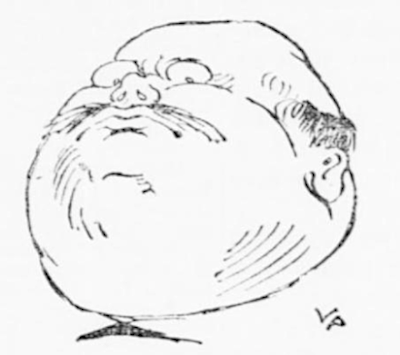Valdemar Andersen, Portrait of Peter Adler Alberti
for the daily Social-Demokraten, 1905.
The Spectacular Downfall Of A Brazen Crook is part of the subtitle on the podcast now made (equally great) book by Rachel Maddow and Michal Yarvitz on Nixon's Vice President Spiro Agnew. Agnew was indeed spectacular in his doing away with everything - people as well as the law - that stood in his way of filling his pockets. If his actions give off a whiff of a later and very recent presidency it is no coincidence.
In Denmark we have Peter Adler Alberti.
Alberti was cut from the same mold as Agnew and No. 45. A petty criminal, who threatened the very fabric of society. As it was stated at the time: politics was a means, not a passion to him. He was minister of justice (!) 1901-1908. He was soon known for his abuse of power in every way possible. The "non-albertiners" would be forced out. He moved within a steadily growing scheme of transactions, embezzlements, speculations and forgeries. The liberal press was on to him and he attempted to reinstate censorship against the press with a side-eye to those pesky cartoonists.
The theatre became the prototype for what would have been the situation of the press too had he been successful. An official theatre censor was put in place making it understood that Alberti's name must not be mentioned onstage. The theatre directors made certain to make a personal ally in him, paying - shall we say paying visits - at his office.
Alberti, of course, had a daily of his own Dannebrog to turn the press off the scent of his actions.
Valdemar Andersen, Portrait of Peter Adler Alberti
for the daily Social-Demokraten, May 23, 1905.
The headline says "Bel Ami" and right below "His great political coup".
General elections was held in 1905 and the newspaper Social-Demokraten was on the spot running a daily column against his re-election. They already had a cartoonist at hand, Djalmar Christofersen, but for their drumming in Alberti The Crook on the minds of their readers they had Valdemar Andersen draw his portrait.
Valdemar was young and new in the field taking up work wherever he could at this time literally running through Copenhagen from assignment to assignment. He went for a simple and striking effect and so Alberti was created into a balloon.
In person Alberti was said to cut a tall and arrogant figure to which was added his growing corpulence. So from his habit of looking down upon his fellow men, his extra chins made for a great focus point with his beading eyes all the haughtier.
Besides, a balloon lives it life on the brink of blowing up so the daily balloon was accompanied by a quotation from the novel Bel Ami; Or, The History Of A Scoundrel by Guy de Maupassant. The present example reads:
"You see, my dear fellow, it is just about having the audacity needed. A shrewd man easier becomes minister than office manager. It is not difficult to have the appearance of something excellent (...) Just need to maneuver a little deftly (...) All people are stupid as geese and ignorant as carps".
Eventually, though, his actions caught up with him. September 8, 1908 he turned himself in.
That could make for a moral tale with everything put to right in the end. This was Alberti, however, and he was given special treatment even while confessing his criminal schemes at the Copenhagen Courthouse. The cartoon to the left is NOT by Valdemar Andersen, but Djalmar Christofersen in Social-Demokraten, September 11, 1908.
The papers were picking up every single detail of the proceedings such as his being placed in an armchair within the balustrade meant to demarcate the line between civilians and the law.
So when it was time to sum up 1908 Valdemar Andersen drew an unnamed, but unmistakable Alberti, this time placed on the outside like everybody else. He is still in his armchair and stretching out a disrespectful shoe on the balustrade. The beam is now crossing his face in that he has trouble facing the light of day:
Valdemar Andersen, Vignet for the annual satirical magazine Plat'Ménagen, 1908.
Photo: Niels C.B. Larsen.
The autumn 1908 also brought a new platform for Valdemar Andersen when he became a cartoonist at the newspaper Politiken that he would be working for from then on. That same very same autumn he created the poster for the paper, which has since become an icon.
His wife Juliane is posing as the quintiessential modern and emancipated woman and she happens to look at the cartoon of the day. Now, this can never be verified, but high-placed windows signify prison cells. Nor is it identical, but it would be in line with Valdemar to highlight the work of a colleague, in this case Axel Nygaard, who created the perhaps most significant cartoon in the papers 1908 of Alberti in his prison cell. The one scene no one would ever see in real life and for that reason all the more satisfactory to have it drawn on paper.
It shall remain a guess, but Valdemar would playfully place such little hints.
Valdemar Andersen, detail of the poster for the daily Politiken, 1908.
Shown with permission from Designmuseum Danmark.
I apologize for the poor quality of the photo. It was taken by me for study purposes.






